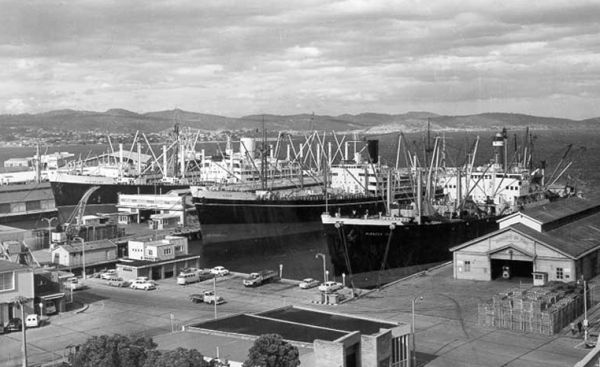 |
 |
|
Cold War Period
The Cold War period had little direct impact on Tasmania during the Menzies years, apart from two major events: the split in the Australian Labor Party (ALP) at the 1955 party conference in Hobart, and the Hursey case which dominated politics on the waterfront (1957–59). Although Tasmanians voted Yes in the 1951 referendum to ban the Communist Party, it was only by a majority of 805 out of 164,833 votes cast. Tasmania is the state in Australia with the smallest Catholic community (18 percent in both 1954 and 1961 censuses), so although speakers came through the Catholic churches and schools to warn of the evils of communism, this, combined with the small size of the local Communist Party, meant the 'fear factor' had little impact on most Tasmanians. Another factor was the right-wing nature of the ALP state government led by Robert Cosgrove. The Communist Party in Tasmania ran candidates in both state and federal elections, but the most support it ever received was when Max Bound received 2003 votes in December 1955. More typical were the 91 votes he won in Denison in 1956, and 92 votes (0.3 percent) in the 1964 state election. While the Industrial Groupers fulminated against communists in the trade unions, there were only two prominent communists in Tasmania's unions: Jack Stanistreet in the Australian Railways Union in the Launceston railway workshops, and Tas Bull in the Waterfront Workers' Federation in Hobart. The ALP was split over how serious the communist threat was to Australia – both internally in the unions, and externally in the region – and the matter came to a head at the party conference in March 1955. The dissident core group from Victoria led the walkout, but the leader of the breakaway Anti-Communist Labor Party (from 1956 the Democratic Labor Party or DLP) was the former Tasmanian Labor Senator George Cole, who held his seat till 1964, transferring his allegiance to the new party after the split. The DLP ran candidates in both state and federal elections in Tasmania until 1974, but its maximum membership was only around 500 and candidates often lost their deposits. They organised statewide speaking tours, but most lecturers came from Victoria. BA Santamaria's National Civic Council, whose membership closely overlapped with the DLP, was active in Tasmania after its foundation in 1957, with its News Weekly sold outside Catholic churches. After 1974 the DLP petered out, as Australians realised that communism was not really a threat. The Hursey case achieved national prominence from 1957 to 1959, when Frank and Dennis Hursey, two staunch Catholics who worked on the waterfront, refused to pay a Waterfront Workers' Union levy. The union denied them a ticket and the legal battle went on for three years as father and son fought for their right to work, crossing the waterfront picket lines over many months. Their legal case was conducted by the Tasmanian Liberal Senator, Reginald Wright. Stanley Burbury ruled in their favour in the Supreme Court in 1958, but in the following year was overruled by the High Court which established the legality of political levies and the right of unions to expel for non-payment. Further reading: P Jones, 'Anti-communism in Tasmania in the late 1950s', MHum thesis, UT, 1995; T Bull, Life on the waterfront, Sydney, 1998; A Lohrey, The morality of gentlemen, Sydney, 1990; L Robson & M Roe, A short history of Tasmania, Melbourne, 1997. Peter Jones
|
Copyright 2006, Centre for Tasmanian Historical Studies |
